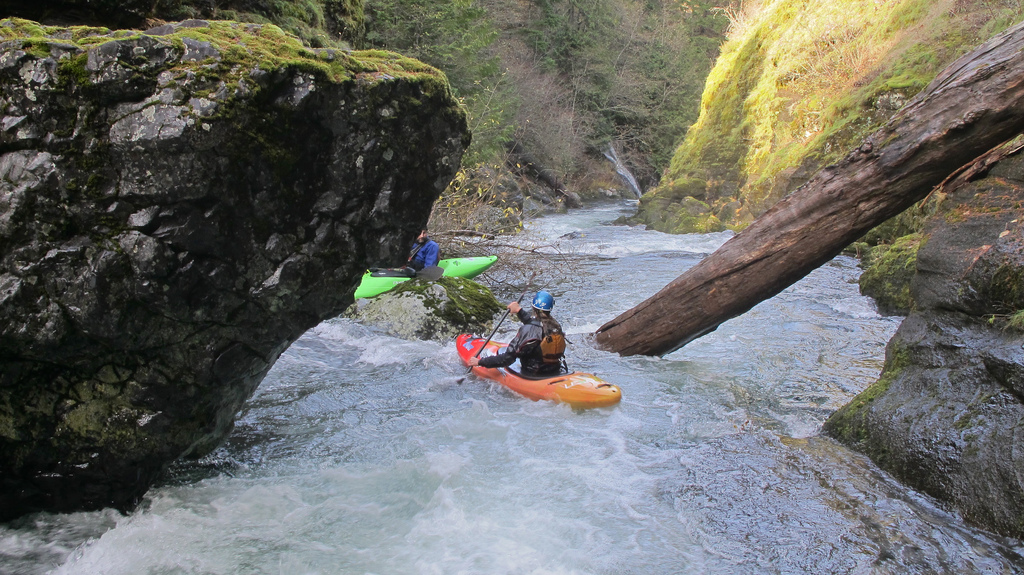There was a time, not so long ago, when I believed winter kayaking was only for those who were tinfoil-hat crazy.
The idea of splashing through rapids on an ice-cold mountain stream in January seemed the height of lunacy and a foolproof way to develop hypothermia.
But then I tried it.
That first season was among the most enjoyable of my life. The ability to paddle tiny creeks that rise during winter, through forests dripping with moss and below polished black canyon walls, adds a new element of adventure to a sport most people enjoy only on hot summer days.
“The reason we go winter kayaking is because the really interesting rivers, the really beautiful ones, need rain to be high enough to run,” said Zach Collier, owner of Northwest Rafting and Sundance Kayak School in Hood River. “With advances in the quality of the equipment, it’s definitely not as cold as you’d think. For the most part, you’re pretty comfortable.”
And despite the extreme image of kayaking that pops up in the media now and again — people launching themselves off 189-foot waterfalls or navigating crocodile-infested waters in the Congo — it’s not a sport necessary dominated by adrenaline-seeking 20-year-olds.
I’ve paddled with people from 16 to 74 years old, who use inflatable and hard-shell boats. There are numerous runs in Northwest Oregon rated Class III or below, meaning that beginner and intermediate paddlers have an almost endless list of choices.
“We call this area a kayaker’s paradise,” said Laurie Pavey, a member of the Willamette Kayak and Canoe Club who helped edit the kayaking book “Soggy Sneakers.” “When the rains come, there’s so many fun little rivers that the toughest thing is deciding where to paddle.”
Getting started
Among all the bad ideas in the world, setting your boat upon a wild Oregon stream without a basic foundation of skill is probably in the top five.
There’s no better way to get slammed against rocks, slapped by rapids and trapped underwater than going kayaking without knowing what the heck you’re doing.
The good news is there are numerous businesses, organizations and people that offer instruction in Northwest Oregon.
There are at least four places that offer classes, which cost from $45 to $2,000 and include everything from basic roll classes to multi-day expedition and teaching trips.
Another option for learning is pool sessions — where practice takes place in the safety of a swimming pool often staffed by experts. Local clubs sponsor pool sessions in Portland, Salem and Corvallis multiple times each month.
“Kayaking is a team sport,” longtime Salem kayaker Anthony Boesen said. “Taking a class, going to the pool and working through local clubs are the best ways to meet other kayakers and really get started.”
Gearing up for winter
Once the skills are polished and you’re ready to take the next step into the world of winter kayaking, there’s a few important pieces of equipment to obtain.
The most important is a drysuit, which encases your body in a waterproof cocoon of warmth that allows you to jump into the river and stay completely dry.
“You really can’t kayak safely in the winter without one,” Collier said. “You just get too cold. If you fall out of your boat and swim, you can get hypothermic very quickly (without a drysuit).”
The problem is cost. New suits typically run anywhere from $500 to $1,200, and used items are rare and typically in bad shape.
Some boaters who go during the spring season and during warmer temperatures use a high-quality wetsuit, which usually is cheaper.
Beyond the drysuit are other items that are optional but improve the experience. Gloves or “pogies” ($20 to $40) keep hands warm, a skull cap ($20 to $40) keeps your head toasty and booties ($60 to $150) help keep your feet stable when portaging your boat on slick riverside rocks.
The best way to get a deal is to simply cruise shops with used gear such as Next Adventure in Portland, along with looking for sales and gear swaps at Alder Creek in Portland and Peak Sports in Corvallis.
Another great way to obtain cheap gear is by joining email lists such PDXkayaker.com, where local boaters always are selling used gear.
Winter-only opportunities
Collier had planned to go skiing at Mount Hood on the Saturday morning he woke up last winter. One phone call changed all that.
“My friend called and said, ‘Opal Creek is running,’ ” Collier said. “I had to drop everything and change my plans because you don’t miss a chance like that.”
Clear as a turquoise blade and surrounded by silver canyons and old-growth trees, Opal Creek is one of the streams that make winter kayakers salivate despite the difficultly.
The creek is only runnable after heavy rains. Reaching the put-in requires a one-mile hike, and the rapids are expert-level Class IV.
Still, the chance to float through pristine wilderness is one of reasons people devote themselves to this sport with such evangelic zeal.
Not that you need to be an expert. The so-called kayaking bible “Soggy Sneakers” is packed with options of Class I, II and III rivers from the Coast Range to the Cascades, including the Little North Santiam, Siletz and Molalla rivers — to name a few.
“Once you develop the basic skills, people fall in love with it,” Collier said. “It can change people’s lives — it certainly changed mine.”



